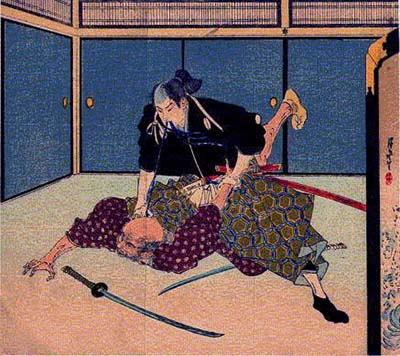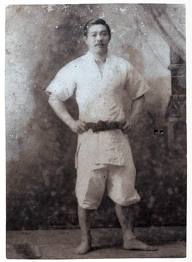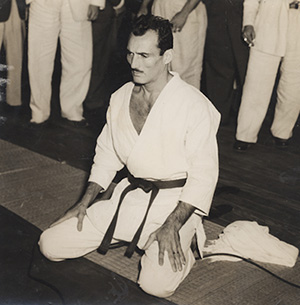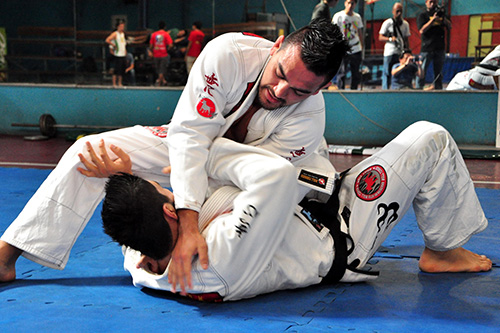- Texts about the art
- by Super User
Teachers
Damjan Cingarski
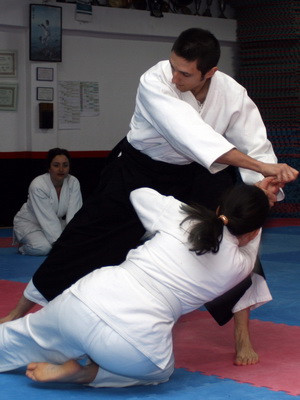 Born in 1978 in Skopje.
Born in 1978 in Skopje.
Education: Master of Architecture (Faculty of Architecture - Skopje)
Proffesion: Architect
Martial arts involvement:
His Aikido beginings are in 2000. In 2002 he starts practicing under the mentorship of Michele Quaranta sensei. He founded the Aikido club Henbo in Skopje in 2005. The following year, 2006, he founded the Aikido Ikeda dojo - Skopje, and became the president of the Macedonian Aikido Federation - Aikikai Macedonia.
In September 2012, he traveled to Japan for the first time, at the aikido congress organized by the International Aikido Federation (IAF). On the same occasion, he practices and studies for a week in the center of the aikido world - Aikikai Hombu in Tokyo, in the classes of Doshu Moriteru Ueshiba and Waka sensei Mitsuteru Ueshiba.
He has participated in two congresses of the International Aikido Federation (IAF) in Japan, in over 170 aikido seminars around the world, of which 15 are weekly aikido summer schools. From 2011 onwards, he himself holds aikido seminars in the country, but also abroad: Bulgaria, Serbia, Switzerland and Ukraine.
By teaching the regular trainings in his club and by holding seminars in the country and abroad, he actively works to spread the school for the didactic system of Masatomi Ikeda sensei.
For all the degrees, he passed in front of Michele Quaranta sensei. Presently he holds the rank of 4th Dan (from 2019).
Michele Quaranta 7. Dan Aikikai
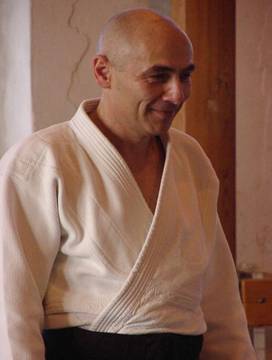 Born on 24th of December 1953.
Born on 24th of December 1953.
Languages that he speaks: Italian, Spanish, French, German, Portuguese and English.
Aikido: Starting in 1972, he has been practicing aikido for over 36 years continually. He holds the rank of 7th Dan in aikido and the title Shihan given to him by the Aikikai Foudation. He was a student and assistant (uke) of Masatomi Ikeda sensei for 20 years and followed him to almost all his seminars.
Professional profile: He was a professional football player in FC Nordstern (premier league) in the past. He was working as a professional football coach for a certain period of time, and also worked as a bank clerk. Finally he turns proffesionaly towards aikido. For 20 years he was continuously an assistant of M. Ikeda sensei. After the retirement of Ikeda sensei from the active aikido life in 2001, Quaranta sensei continues to teach and to spread out the aikido by the methodology inherited from M. Ikeda sensei.
Aikido schools: He founded his own dojo in Basel (Switzerland) in 1983 (www.aikidoschule-basel.ch). All over Europe there are noumerous schools with over 3000 aikidokas that he mentors.
Internationally, he is known as the Technical manager and member of the technical committees of various countries which appreciate his knowledge and dedication to aikido.
Apart from aikido he is also teaching HOJO (a discipline developed at the famous swordsmanship school Kashima Shinden Jikishinkage Ryu which exists from the 14th century.
Seminars: He teached aikido in the following countries: Switzerland, Poland, Slovakia, Czech Republic, Serbia, Netherlands, Ireland, Macedonia, Austria, Bulgaria, Croatia, Ukraine, Egypt, G. Britain USA and Japan.
Shihan Masatomi Ikeda 7. Dan Aikikai
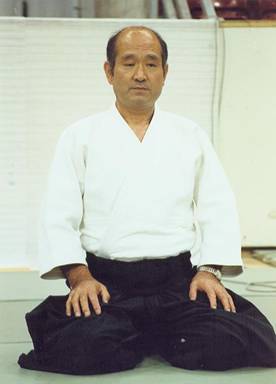 Born in Tokyo, 8th of April 1940.
Born in Tokyo, 8th of April 1940.
Education: Faculty of physical education, Nihon Taiku University, Tokyo.
Aikido: he has been practicing since 1958 and has been active in Aikido for more that 41 years; he is a bearer of 7th Dan Aikikai Aikido, 5th Dan Sumo, and 4th Dan Judo belts. His Aikido teacher was mostly Hiroshi Tada 9th Dan Aikikai. Hi receives his last degree in aikido in 1989.
Dwelling history: till 1965 lived in Japan, from 1965-1970 in Italy, from 1970 until 1977 again in Japan where he (was a teacher at the sport high school.) from 1977 he has lived in Zurich where he has founded the school Aikido Ikeda Dojo Zurich. He hasn’t been teaching aikido since 2001 because of his illness.
Management: from 1977 he has been the technical manager of the Swiss Aikido Federation, of the Czech Aikido Federation from 1995, of the Slovakian Aikido Federation since 1996 and from 1997 until 2003 of the Yugoslavian Aikido Federation. In 1998 he became the technical manager of the International Aikido Federation (IAF) together with Mr. H. Isoyama 9th Dan Aikikai.
After his arrival in Switzerland, Ikeda sensei realized that the traditional way of teaching aikido is not suitable for the Europeans because of the great cultural differences with the Japanese. There are certain things that in Japan go without saying, but they have to be explained carefully in Europe. Having in mind those differences, Ikeda sensei compiled a didactical system and an examination program, which simply amaze with the geniality with which they were presented.
Apart from aikido he also taught HOJO (a discipline developed at the famous school Kashima Shinden Jikishinkage Ryu which exists from the 14th century. A special bokken (wooden sword) is used in Hojo. He also organized seminars in Genki Kai - special health system which derives from aikido and is a unique synthesis of the western and eastern health system.
Seminars: He held aikido seminars on a regular bases in these countries: Italy, Switzerland, Spain, Sweden, Nederland, Finland, Poland, France, Austria, Croatia, Germany, Slovakia, Czech, Japan, Turkey, Russia, Serbia and in Monte Negro.
O sensei Morihei Ueshiba - The aikido founder
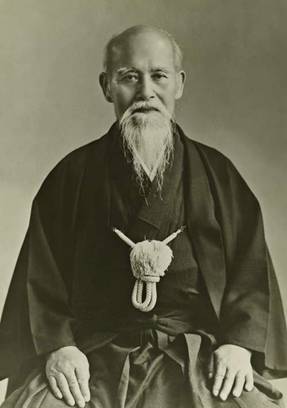 The founder of aikido, Morihei Ueshiba was born on 14th of December 1883 in an agricultural family, in the Vakayama prefacture, now known as Tanabe. He was the only male child in a family with 5 children. From his father he inherited the samurai designation and the interest for the public events and from his mother the interest for religion, poetry and art. In his early childhood he was a weak and often sick child, which was the reason for him to sit at home and read books instead of playing outside with the other children.
The founder of aikido, Morihei Ueshiba was born on 14th of December 1883 in an agricultural family, in the Vakayama prefacture, now known as Tanabe. He was the only male child in a family with 5 children. From his father he inherited the samurai designation and the interest for the public events and from his mother the interest for religion, poetry and art. In his early childhood he was a weak and often sick child, which was the reason for him to sit at home and read books instead of playing outside with the other children.
He wanted to listen about the magical legends, En no Goya and Kobo Daishi, and was fascinated by the Buddhist rituals. From time to time Morihei thought of the possibility of becoming a priest. Morihei’s father, Jorki, was trying to change his son’s mind about that idea and encouraged him to start practicing sumo and swimming, motivating him with the stories about his great grandfather, who was considered to be one of the best samurais of his time.
In time Morihei became very strong and finely his idea came true, after his father, who was in politics at that time, was attacked and beaten up by a group of hooligans hired by his political opponents. Morihei, being only 158 cm tall, managed to be at 80 kilos muscle weight. He didn’t find any particular interest in classical education, since his great energy had the need for more practical knowledge. He was working at various places, doing different assignments and during the period when he was working as a merchant in Tokio, he realized that he had great affinity towards martial arts.
He begun to study jujutsu at Kito-ryu where his master was Tokusabura Tozawa and Kenjutsu at Shinkage-ryu. In 1901 he got the certificate for successfully ended training at Kito-ryu. A few years after that, he got the certificate for Kenjutsu from his master Masakatsu Nakai. He got sick and had to return home, where he later married Itogawa Hatsu. During the Russian-Japanese war in 1903, he volunteered in the army, infantry. His superiors were impressed by him and they recommended him to the national military academy. Morihei refused the offer and returned home. Driven by the great desire to continue the physical training, he built a dojo at his farm and invited the famous for his time, jujutsu instructor Takaki Kiyoici to be his personal teacher (?). During this period of time he realized that he owned a great, above average, talent for martial arts and in the same time he showed great interest in politics.
In the spring of 1912, at the age of 29, he moved to Hokaido together with his family. After a few difficult years, the village he moved to begun to prosper. Morihei Ueshiba became very strong, that his strength was a subject of various stories that were going around. During the time of his stay at Hokaido he met the great master in Daito-ryu Aiki Jujutsu, Sokaku Takeda. Being certain that he wouldn't find a better teacher than him, Ueshiba completely devoted himself to the study of Daito-ryu Aiki Jujutsu.
After a few months he went back to Shirataki and invited Sokoku Takeda to live with him and teach at his dojo. Hearing about the illness of his father, Ueshiba traveled back to Hokaido. During his trip he made a stop at Ayabe, the center of Omotokyo religion. There he met the leader of the new religion, Deguchi Onisaburo.
Since he was, so to say, charmed or enchanted by Ayabe and by Deguchi, he stayed an additional three days there. Meanwhile his father dies, and it was very heavy on Morihei heart. He made a decision to move to Ayabe and learn about the Omotokyo. He stayed there for the next eight years. Deguchi was a distinguished pacifist, who pledged for universal disarmament. It is intriguing how a man of his nature could get so close to a man from the world of the martial arts, as Ueshiba was. Be it as it may, it didn’t take long time before Deguchi realized that the true goal of Ueshiba was to learn the true meaning of budo and to put an end to all the battles and conflicts. The study of the Omotokyo religion and the closeness with Onisaburo had great impact on Morihei’s life.
Ueshiba made a statement that Sokaku Takeda had opened his eyes about budo, but he had experienced enlightenment through Omotokyo. According to what he had said, in the time of his early forties, somewhere around 1925, he had encountered many spiritual experiences, which changed his life and his way of practice forever. He understood that the true cause of budo is love which needs to be shared with every living thing.
In the next years the number of Morihei’s students was constantly growing. Among the students were Tomiki Kenji and the famous admiral TAkeshita. Deguchi encouraged Morihei to separate himself from the Omokjoto and to continue on his path. He, than, moves to Tokyo and because of the increased number of students he had to built an official dojo in the area of Ushigome, today the headquarters of a Aikikai.
Right after the dojo was built, highly ranked teacher from other martial arts came to visit him, among who was the creator of judo, Jigoro Kano. They where very impressed and sent their studens to learn from Ueshiba. In 1932 Ueshiba was appointed for head instructor. At that time Gozo Shioda, Shirata Ringiro and others joined the dojo. Up to the outbreak of the Second World War Ueshiba was too busy with the classes he gave to Kobukan and with holding special training classes at the military and police academy. In the next ten years Morihai became very popular and many stories about his personality started to be spread around.
In 1942 he returned to his farm. He often stated that budo has a lot in common with agriculture. During the war Kobukan was nearly empty. This was why he entrusted it in the hands of his son Kishomaru. Morihei moved to Ibaraki prefecture in the village of Iwama. There he built a dojo and an Aiki sanctuary, which is still famous and is being visited even today. After the war Aikido was spreading quickly, especially in Kobukan, now named Aikikai Hombu Dojo, under the leadership of Kishomaru Ueshiba. Morihei is being called O Sensei, as the only supreme master of Aikido. He received many decorations from the Japanese government.
Until the end of his life O Sensei never stopped improving the path and he never lost his dedication to a hard training. In the early spring of 1969 he got very sick and on his request was transferred to his home, nearer to his dojo. He died on 26 of April 1969 at the age of 86. Among the last word he uttered were those that Aikido is designed for the whole world and should be taught, not selfishly, but to all people, all around the world.




